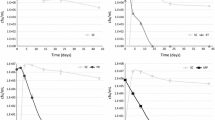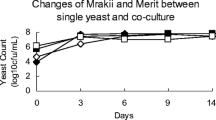Abstract
Effects of tourmaline ceramic balls on growth and metabolism of Saccharomyces cerevisiae, Lactobacillus acidophilus and Aspergillus oryzae were studied. Treatments with 3, 6, 9 or 12 g of tourmaline ceramic balls in a 50 ml culture showed significant stimulation of the growth of the three microorganisms. In optimal treatments with 12 g of tourmaline balls, the growth of S. cerevisiae, L. acidophilus, and A. oryzae was increased by 34, 32 and 10%, respectively. After 72 h fermentation of S. cerevisiae, total carbohydrate content in the culture medium was decreased by 65% and ethanol production was increased by 150%. Total carbohydrate content was decreased by 80% and the pH value was decreased by 0.3, as a result of organic acid production in the medium of L. acidophilus after 72 h fermentation. In the case of A. oryzae, enzyme activities of protease and amylase were increased by 90 and 31%, respectively, after 96 h fermentation. Results indicated that tourmaline stimulates initiation of growth in the early lag stage and increases production of metabolites at a later stage of fermentation. The strong stimulatory effect of tourmaline on growth, utilization of substrates and production of metabolites in the three microorganisms suggests a potential application in the fermentation industry.




Similar content being viewed by others
References
Amat A, Rigau J, Waynant RW et al (2006) The electric field induced by light can explain cellular responses to electromagnetic energy: a hypothesis of mechanism. J Photochem Photobio B Biol 82:152–160
Archer S, Li T-T, Evans AT et al (1999) Cell reactions to dielectrophoretic manipulation. Biochem Biophys Res Commun 257:687–698
BeMiller JN (1964) Iodimetric determination of amylase, In Methods in Carbohydrate Chemistry, vol IV. Academic Press, New York, pp 165
Beschkov V, Velizarov S, Agathos SN et al (2004) Bacterial denitrification of waste water stimulated by constant electric field. Biochem Eng J 17:141–145
Choy KL (2003) Chemical vapour deposition of coatings. Progress in Mater Sci 48:57–170
Cramariuca R, Donescub V, Popac M et al (2005) The biological effect of the electrical field treatment on the potato seed: agronomic evaluation. J Electrostatics 63:837–846
Dubois M, Gilles KA, Hamilton JK et al (1956) Colorimetric method for determination of sugars and related substances. Anal Chem 28:350–356
Ellaiah P, Saisha V, Srinivasulu B (2003) Effect of low frequency AC electric fields on urokinase production by MPGN kidney cells. Process Biochem 39:1–4
Esgalhado ME, Roseiro JC, Collaco MTA (1995) Interactive effects of pH and temperature on cell growth and polymer production by Xanthomonas campestris. Process Biochem 30:667–671
Gergory JK, Clary DC, Liu K et al (1997) The water dipole moment in water clusters. Science 275:814–817
Home RW (1976) Aepinus, the tourmaline crystal, and the theory of electricity and magnetism. Isis 67:21–30
Ji ZJ, Jin ZZ, Liang JS (2002) Influence of tourmaline on pH value of water. China Environ Sci 22:515–519, (in Chinese)
Jin HM, Hang GB, Zhang GP (2003) Effects of tourmaline on the proliferation of human endothelial cells using millicell membrane culture dish. J China Microcircul 7:309–11 (in Chinese)
Jin ZZ, Ji ZJ, Liang JS et al (2003) Observation of spontaneous polarization of tourmaline. China Phys 12:222–225
Kaiser F (1996) External signals and internal dynamics: biophysical aspects and modeling approaches for interactions of weak electromagnetic fields at the cellular level. Biochem Bioenerg 41:3–18
Kubo T (1989) Interface activity of water given rise by tourmaline. Solid State Phys 24:121–123
Lechleiter J, Girard S, Peralta E et al (1991) Spiral calcium wave propagation and annihilation in Xenopus laevis oocytes. Science 252:123–126
Liu K, Cruzan JD, Saykally RJ (1996) Water clusters. Science 271:929–933
Nakamura T, Kubo T (1992) The tourmaline group crystals reaction with water. J Ferroelectr 137:13–31
Nakamura T, Fujishiro K, Kubo T et al (1994) Tourmaline and lithium niobate reaction with water. Ferroelectrics 155:207–212
Panagopoulos DJ, Messini N, Karabarbounis A (2000) A mechanism for action of oscillating electric fields on cells. Biochem Biophys Res Commun 272:634–640
Panagopoulos DJ, Karabarbounis A, Margaritis LH (2002) Mechanism for action of electromagnetic fields on cells. Biochem Biophys Res Commun 298:95–102
Rivas L, Soares CM, Baptista AM et al (2005) Electric-field-induced redox potential shifts of tetraheme cytochromes c 3 immobilized on self-assembled monolayers: surface-enhanced resonance raman spectroscopy and simulation studies, Biophys J 88:4188–4199
Saux AL, Ruysschaert J–M, Goormaghtigh E (2001) Membrane molecule reorientation in an electric field recorded by attenuated total reflection fourier-transform infrared spectroscopy. Biophys J 80:324–330
Shevkunov SV, Vegiri A (2002) Electric field induced transitions in water clusters. J Mol Stru 593:19–32
Stulen G (1981) Electric field effects on lipid membrane structure. Biochim Biophys Acta 640:621–627
Vaughan TE, Weaver JC (1998) Molecular change due to biomagnetic stimulation and transient magnetic fields: mechanical interference constraints on possible effects by cell membrane pore creation via magnetic particles. Bioelectrochem Bioenerg 46:121–128
Xia MS, Hu CH, Zhang HM et al (2003) Effects of tourmaline treated-water on the growth and the activity of alkaline phosphatase of caco-2 cell. China J Cell Biol 2:222–2255 (in Chinese)
Xia MS, Hu CH, Zhang HM (2006) Effects of tourmaline addition on the dehydrogenase activity of Rhodopseudomonas palustris. Process Biochem 41:221–225
Yamaguchi S (1983) Surface electric fields of tourmaline. Appl Phys A Solids Surfaces 31:183–185
Yoshitake N, Ayumu Y, Kazuya O (1996) pH self-controlling induced by tourmaline. J Intel Mater Syst Stru 7:260–263
Zawisza I, Lachenwitzer A, Zamlynny V et al (2003) Electrochemical and photon polarization modulation infrared reflection absorption spectroscopy study of the electric field driven transformations of a phospholipid bilayer supported at a gold electrode surface. Biophysic J 85:4055–4075
Zhang JP, Zhao L, Tan X (2004) Structural change of water clusters and the corresponding biological effects. Chemistry 67:278–283 (in Chinese)
Acknowledgments
Special thanks to Dr. Qiaoping Yuan at the National Institutes of Health (NIH), Bethesda, Maryland, USA, for reading the manuscript and valuable suggestions to this research. This research was supported by Science and Technology Programs of Guangdong Province (program number 2006B20101005).
Author information
Authors and Affiliations
Corresponding author
Rights and permissions
About this article
Cite this article
Ni, H., Li, L. & Li, HH. Tourmaline ceramic balls stimulate growth and metabolism of three fermentation microorganisms. World J Microbiol Biotechnol 24, 725–731 (2008). https://doi.org/10.1007/s11274-007-9529-x
Received:
Accepted:
Published:
Issue Date:
DOI: https://doi.org/10.1007/s11274-007-9529-x




